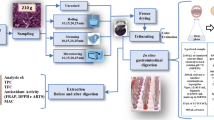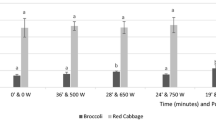Abstract
The effect of microwave cooking on vegetables was analysed regarding parameters affecting postprandial glycaemic overload and oxidative stress. Microwave cooking affected the biological activities in different vegetables different ways. Rat intestinal α-glucosidase inhibitory activity was not affected by cooking in yellow cucumber, ridge gourd, radish root and bladder dock juice, however, it was reduced in bottle gourd. On the other hand, an increase in α-glucosidase inhibitory potential was noticed after cooking in green amaranthus. Similarly, free radical scavenging activity increased due to cooking in vegetable juice except in bladder dock and palak. Antihaemolytic activity increased in bottle gourd, radish root, palak and green amaranthus, and decreased in yellow cucumber and bladder dock juice after cooking. However, it was not affected in ridge gourd and radish leaves. Cooking augmented antiglycation properties in the juice of ridge gourd, radish root and leaves, but mitigated those properties in yellow cucumber and bladder dock. No change in antiglycation potential was noticed due to cooking in bottle gourd and green amaranthus leaf juice. Cooking increased total polyphenol content in vegetable juice, however, varied results were obtained for total flavonoid content. Substantial loss in protein content due to cooking was recorded in all vegetables. Although among the studied vegetables, the juice of ridge gourd and radish root displayed a majority of biological activities, the juice of raw yellow cucumber displayed better α-glucosidase inhibition, free radical scavenging and antihaemolytic and antiglycation activities. Therefore, raw yellow cucumber juice may become a cost-effective nutrafood helpful in mitigating disorders of glycaemic overload and oxidative stress.
Similar content being viewed by others
References
Ceriello A (2005) Postprandial hyperglycemia and diabetes complications. Is it time to treat? Diabetes 54:1–7
Weeratunga P, Jayasinghe S, Perera Y, Jayasena G, Jayasinghe S (2014) Per capita sugar consumption and prevalence of diabetes mellitus: global and regional associations. BMC Public Health 14:186
Bray GA, Popkin BM (2014) Dietary sugar and body weight: Have we reached a crisis in the epidemic of obesity and diabetes? Health be damned! Pour on the sugar. Diab Care 37:950–956
Sies H, Stahl W, Sevanian A (2005) Nutritional, Dietary and postprandial oxidative stress. J Nutr 135:969–972
Ceriello A, Motz E (2004) Is oxidative stress the pathogenic mechanism underlying insulin resistance, diabetes, and cardiovascular disease? The common soil hypothesis revisited. Arterioscler Thromb Vasc Biol 24:816–823
Kim JY, Kwon O (2011) Culinary plants and their potential impact on metabolic overload. Ann N Y Acad Sci 1229:133–139
Ley SH, Hamdy O, Mohan V, Hu FB (2014) Prevention and management of type 2 diabetes: dietary components and nutritional strategies. Lancet 383:1999–2007
Leonti M (2012) The co-evolutionary perspective of the food medicine continuum and wild gathered and cultivated vegetables. Genet Resour Crop Evol 59:1295–1302
Tiwari AK (2014) Revisiting “vegetables” to combat modern epidemic of imbalanced glucose homeostasis. Pharmacogn Mag 10[Suppl 2]:S207–S213
Imai S, Fukul M, Ozasa N, Ozeki T, Kurakawa M, Komatsu T et al (2013) Eating vegetables before carbohydrates improves postprandial glucose excursions. Diabet Med 30:370–372
Wang X, Ouyang Y, Liu J, Zhu M, Zhao G, Bao W, Hu FB (2014) Fruit and vegetable consumption and mortality from all causes, cardiovascular disease, and cancer: systematic review and dose-response meta-analysis of prospective cohort studies. BMJ 349:g4490
Link LB, Potter JD (2004) Raw versus cooked vegetables and cancer risk. Cancer Epidemiol Biomarkers Prev 13:1422–1435
Leenders M, Slujs I, Ros MM et al (2013) Fruit and vegetable consumption and mortality. Am J Epidemiol 178:590–602
Williams D, Edwards D, Hamernig I, Jian L, James AP, Johnson SK, Tapsell LC (2013) Vegetables containing phytochemicals with potential anti-obesity. Food Res Int 52:323–333
Miglio C, Chivaaro E, Visconti A, Fogliano V, Pellegrini N (2008) Effect of different cooking methods on nutritional and physiochemical characteristics of selected vegetables. J Agric Food Chem 56:139–147
Jimenez-Monreal AM, Garcia-Diz M, Tome MM, Mariscal M, Murcia A (2009) Influence of cooking methods on antioxidant activity of vegetables. J Food Sci 74:H97–H103
Tiwari AK, Reddy KS, Radhakrishnan J et al (2011) Influence of antioxidant rich fresh vegetable juice s on starch induced postprandial hyperglycemia in rats. Food Funct 2:521–528
Tiwari AK, Jyothi AL, Tejeswini VB, Madhusudana K, Kumar DA, Zehra A, et al (2013) Mitigation of starch and glucoseinduced postprandial glycemic excursion in rats by antioxidant-rich green-leafy vegetables juice. Pharmacogn Mag 9[Suppl]:S66–S73
Tiwari AK, Anusha I, Sumangali M, Kumar DA, Madhusudana K, Agawane SB (2013) Preventive and therapeutic effects of Benincasa hispida and Sechium edule fruit juice on sweet-beverages induced impaired glucose tolerance and oxidative stress. Pharmacologia 4:197–207
Tiwari AK, Kumar DA, Sweeya PSR, Chauhan AH, Lavanya V, Sireesha K, Pavithra K, Zehra A (2014) Vegetables’ juice influences polyol pathway by multiple mechanisms in favour of reducing development of oxidative stress and resultant diabetic complications. Pharmacogn Mag 10[Suppl 2]:S388–S396
Wootton-Beard PC, Brandt K, Fell D, Warner S, Ryan L (2014) Effects of beetroot juice with high neobetanin content on the early-phase insulin response in healthy volunteers. J Nutr Sci 3:e9
Imai S, Fukui M, Kajiyama S (2014) Effect of eating vegetables before carbohydrates on glucose excursions in patients with type 2 diabetes. J Clin Biochem Nutr 54:7–11
Sukhlecha A (2012) Bitter bottle gourd (Lagenaria siceraria): Healer or killer? Int J Nutr Pharmacol Neurol Dis 2:276–277
Tiwari AK, Manasa K, Kumar DA, Zehra A (2013) Raw horse gram seeds posses more in vitro antihyperglycemic activities and antioxidant properties than their sprouts. Nutrafoods 12:47–54
Takebayashi J, Iwahashi N, Ishimi Y, Tai A (2012) Development of a simple 96-well plate method for evaluation of antioxidant activity based on the oxidative haemolysis inhibition assay (OxHLIA). Food Chem 134:606–610
Blincko S, Edwards R (1998) Non-separation assay for glycohaemoglobin. Clin Chem 44:1302–1308
Colombo ML, Falciola C, Maffe S, Davanzo F (2014) Beneficial properties of plants and their derived extracts on the cardiovascular system. Nutrafoods 13:93–101
Standl E, Schnell D, Ceriello A (2011) Postprandial hyperglycemia and glycemic variability. Should we care? Diabetes Care 34[Suppl 2]:S120–S127
Williamson G (2013) Possible effects of dietary polyphenols on sugar absorption and digestion. Mol Nutr Food Res 57:48–57
Boath AS, Grussu D, Stewart D, McDougall GJ (2012) Berry polyphenols inhibit digestive enzymes: a source of potential health benefits? Food Dig 3:1–7
Neri S, Signorell SS, Torrisi B, Pulvirenti D et al (2005) Effects of antioxidants supplementation on postprandial oxidative stress and endothelial dysfunction: a single blind, 15 day clinical trial in patients with untreated type 2 diabetes, subjects with impaired glucose tolerance, and healthy controls. Clin Ther 27:1764–1773
Kinoshita T, Lepp Z, Chuman H (2005) Construction of a novel database for flavonoids. J Med Invest 52:291–292
Prior RL, Wu X, Schaich K (2005) Standardized methods for the determination of antioxidant capacity and phenolics in foods and dietary supplements. J Agric Food Chem 53:4290–4302
Ou B, Prior RL, Huang D (2005) The chemistry behind dietary antioxidant capacity assays. J Agric Food Chem 53:1841–1856
Edwards CJ, Fuller J (1996) Oxidative stress in erythrocytes. Comp Haematol Int 6:24–31
Giacco F, Brownlee M (2010) Oxidative stress and diabetic complications. Circ Res 107:1058–1070
Inouye M, Mlio T, Sumino K (1999) Link between glycation and lipoxidation in red blood cells in diabetes. Clin Chim Acta 285:35–44
Jain SK, Mcvie R, Duett J, Herbst JJ (1989) Erythrocyte membrane lipid peroxidation and glycosylated haemoglobin in diabetes. Diabetes J 38:1539–15743
Yamaguchi T, Mizobuchi T, Kajikawa R, Kawashima H et al (2001) Radical scavenging activity of vegetables and the effect of cooking on their activity. Food Sci Technol Res 7:250–257
Rungapamestry V, Duncan AJ, Fuller Z, Ratcliffe B (2007) Effect of cooking brassica vegetables on the subsequent hydrolysis and metabolic fate of glucosinolates. Proc Nutr Soc 66:69–81
Wu X, Zhou QH, Xu K (2009) Are isothiocyanates potential anti-cancer drugs? Acta Pharmacol Sin 30:501–512
de-Souza CG, Sattler JA, de-Assis AM, Rech A, Perry MLS, Souza DO (2012) Metabolic effects of sulforaphane oral treatment in streptozotocin- diabetic rats. J Med Food 15:795–801
Guerrero-Beltran CE, Calderon-Oliver M, Pedraza-Chaverri J, Chirino YI (2012) Protective effect of sulforaphane against oxidative stress: recent advances. Exp Toxicol Pathol 64:503–508
Morandi A, Tosto C, Sarsini PR, Libera DD (2011) Salutogenesis and Ayurveda: indications for public health management. EPMA J 2:459–465
Author information
Authors and Affiliations
Corresponding author
Rights and permissions
About this article
Cite this article
Kumar, D.A., Anusha, S.V., Oruganti, S. et al. Raw versus cooked vegetable juice. Nutrafoods 14, 27–38 (2015). https://doi.org/10.1007/s13749-014-0066-6
Received:
Accepted:
Published:
Issue Date:
DOI: https://doi.org/10.1007/s13749-014-0066-6




